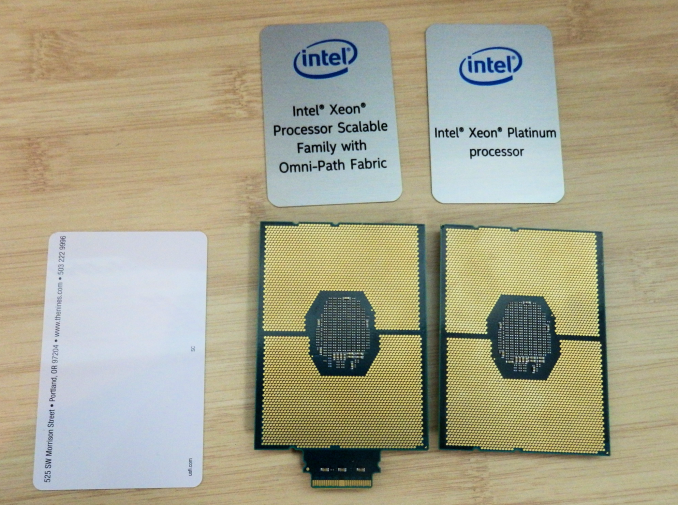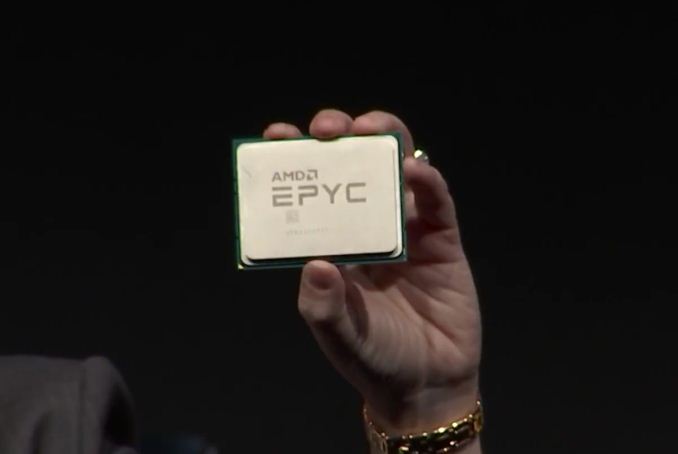Sizing Up Servers: Intel's Skylake-SP Xeon versus AMD's EPYC 7000 - The Server CPU Battle of the Decade?
by Johan De Gelas & Ian Cutress on July 11, 2017 12:15 PM EST- Posted in
- CPUs
- AMD
- Intel
- Xeon
- Enterprise
- Skylake
- Zen
- Naples
- Skylake-SP
- EPYC

This morning kicks off a very interesting time in the world of server-grade CPUs. Officially launching today is Intel's latest generation of Xeon processors, based on the "Skylake-SP" architecture. The heart of Intel's new Xeon Scalable Processor family, the "Purley" 100-series processors incorporate all of Intel's latest CPU and network fabric technology, not to mention a very large number of cores.
Meanwhile, a couple of weeks back AMD soft-launched their new EPYC 7000 series processors. Based on the company's Zen architecture and scaled up to server-grade I/O and core counts, EPYC represents an epic achievement for AMD, once again putting them into the running for competitive, high performance server CPUs after nearly half a decade gone. EPYC processors have begun shipping, and just in time for today's Xeon launch, we also have EPYC hardware in the lab to test.
Today's launch is a situation that neither company has been in for quite a while. Intel hasn't had serious competition in years, and AMD has't been able to compete. As a result, both companies are taking the other's actions very seriously.
In fact we could go on for much longer than our quip above in describing the rising tension at the headquarters of AMD and Intel. For the first time in 6 years (!), a credible alternative is available for the newly launched Xeon. Indeed, the new Xeon "Skylake-SP" is launching today, and the yardstick for it is not the previous Xeon (E5 version 4), but rather AMD's spanking new EPYC server CPU. Both CPUs are without a doubt very different: micro architecture, ISA extentions, memory subsystem, node topology... you name it. The end result is that once again we have the thrilling task of finding out how the processors compare and which applications their various trade-offs make sense.
The only similarity is that both server packages are huge. Above you see the two new Xeon packages –with and without an Omni-Path connector – both of which are as big as a keycard. And below you can see how one EPYC CPU fills the hand of AMD's CEO Dr. Lisa Su.
Both are 64 bit x86 CPUs, but that is where the similarities end. For those of you who have been reading Ian's articles closely, this is no surprise. The consumer-focused Skylake-X is the little brother of the newly launched Xeon "Purley", both of which are cut from the same cloth that is the Skylake-SP family. In a nutshell, the Skylake-SP family introduces the following new features:
- AVX-512 (Many different variants of the ISA extension are available)
- A 1 MB (instead of a 256 KB) L2-cache with a non-inclusive L3
- A mesh topology to connected the cores and L3-cache chunks together
Meanwhile AMD's latest EPYC Server CPU was launched a few weeks ago:
On the package are four silicon dies, each one containing the same 8-core silicon we saw in the AMD Ryzen processors. Each silicon die has two core complexes, each of four cores, and supports two memory channels, giving a total maximum of 32 cores and 8 memory channels on an EPYC processor. The dies are connected by AMD’s newest interconnect, the Infinity Fabric...
In the next pages, we will be discussing the impact of these architectural choices on server software.











219 Comments
View All Comments
Kaotika - Tuesday, July 11, 2017 - link
http://www.anandtech.com/show/11464/intel-announce...This one remains wrong though
Ian Cutress - Tuesday, July 11, 2017 - link
Always reference the newest piece, especially the main review.Or we'd spend half of our time going back and updating old pieces and reviews with new data.
scottb9239 - Tuesday, July 11, 2017 - link
On the POV-RAY benchmark, shouldn't that read as almost 16% faster than the dual 2699 v4 and 32% faster than the dual 8176?scienceomatica - Tuesday, July 11, 2017 - link
I think that a fair game would be to compare the top offer of one and the other manufacturer, in other words, the Xeon 8180 should be included in the benchmark regardless of the aspect of the price. Then the difference would be quite in favor of the Intel processor, although it has few cores less.Tamz_msc - Tuesday, July 11, 2017 - link
Will we get to see more FP HPC-oriented workloads like SPECfp2006 or even 2017 being discussed in a future article?lefty2 - Tuesday, July 11, 2017 - link
I can summarize this article: "$8719 chip beaten by $4200 chip in everything except database and Appache spark."Well done Intel, another Walletripper!
Shankar1962 - Wednesday, July 12, 2017 - link
Then why did google att aws etc upgraded to skylake. They could have saved billions of dollars.Shankar1962 - Wednesday, July 12, 2017 - link
Look at what big players upgrading to skylake reportedThese are real workloads
No one cares about labs
These numbers decide who wins and who loses
No wonder AMD sells at $4200
https://www.google.com/amp/s/seekingalpha.com/amp/...
nitrobg - Tuesday, July 11, 2017 - link
Pricing on page 10 should reflect that the 2P EPYC prices are for 2 processors, not per CPU. The price of Xeons is per CPU.coder543 - Tuesday, July 11, 2017 - link
That doesn't seem true. The prices they currently have seem to be correct. Got a source?